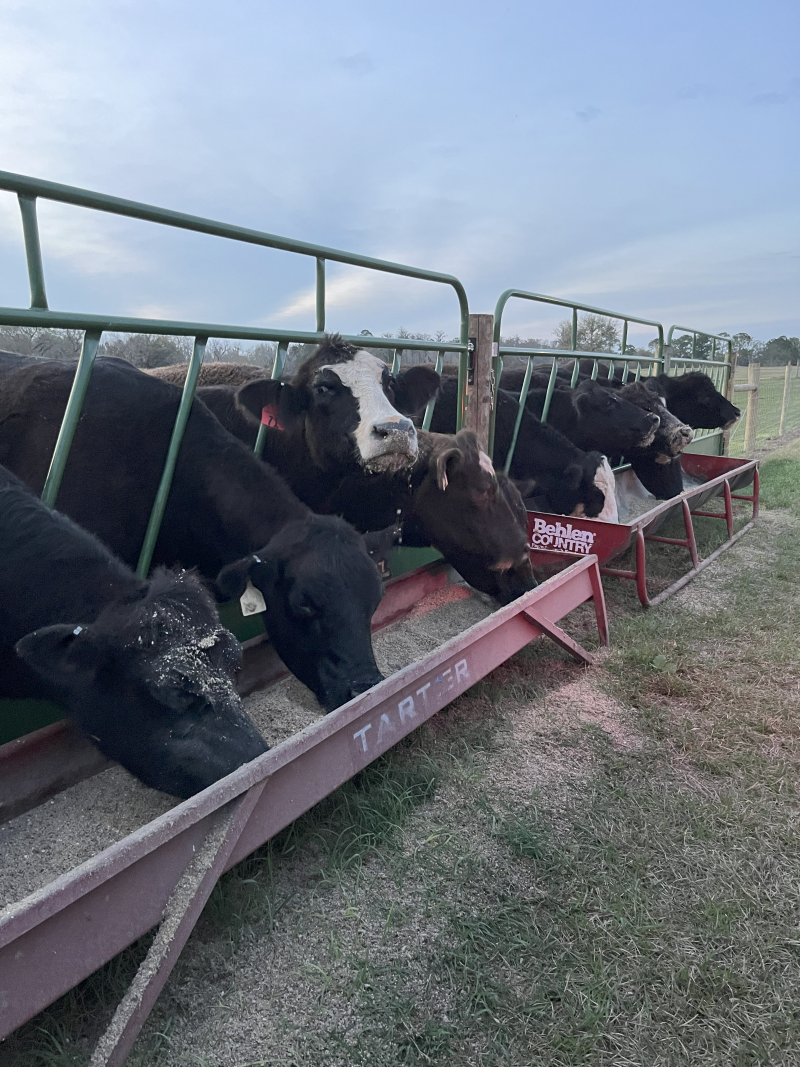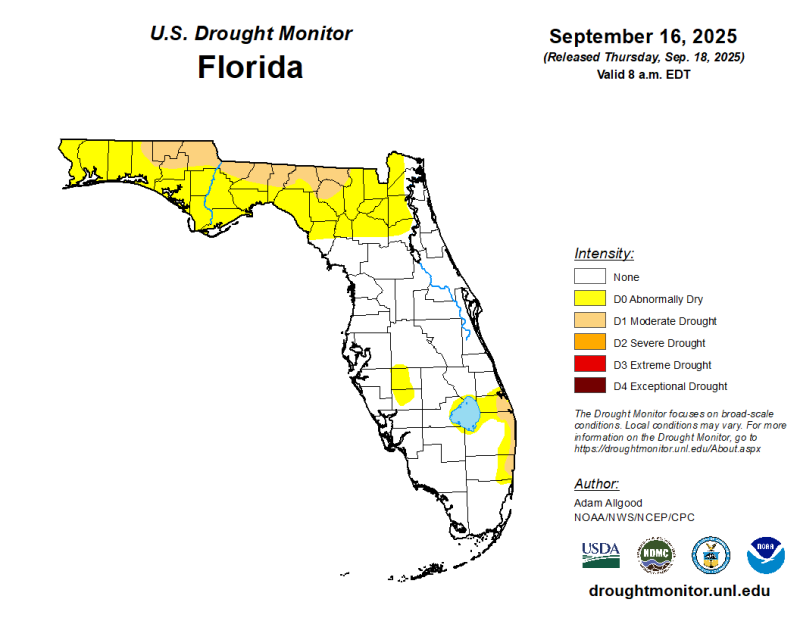With continuous weeks of drought through the end of August and throughout September, all of North Florida is in either the D1 Moderate Drought Category (tan) or D0 Abnormally Dry Category of NOAA’s U.S. Drought Monitor. With limited rainfall, both forage quantity and quality have been negatively affected. Cattle producers are faced with tough decisions this fall and winter. Supplemental feeding two months earlier than normal is expensive, but if it works within your operation to help you get through the drought period without sacrificing future reproductive efficiency, it can be beneficial. This should be considered if your forage quality and quantity continue to decline and reach a point where herd’s nutrient requirements are not being met. For fall calving herds, the question that should be asked is, “What do I need to feed to maintain cow fertility?” rather than, “What are the cheapest feed options available to stretch hay supplies through the winter?”
–

Supplemental feeding of cattle is expensive but maintaining body condition prior to and soon after fall calving is essential for fertility in a controlled breeding season. Credit: Ben Hoffner, UF/IFAS
When to supplement
In a growing season with ideal conditions, nutrient requirements for grazing cattle are met by improved pastures through October. Reductions in forage quantity and quality will only get worse as this current drought continues. This will cause cattle performance to decline if supplemental nutrition is not provided in adequate amounts. In drought situations the first place to start is with body condition score. If cattle are losing condition, it is important to understand which primary nutrient, protein or energy, is lacking. Having your hay tested annually can help you understand which nutrient needs to be addressed with supplemental feeds. Pregnant cattle may only need protein supplementation with decent quality hay. Once cows have calved, their energy requirements spike considerably, requiring a balanced feed supplement with hay to maintain body condition. Understanding what nutrients are missing will help cut the cost of supplement feed if the feed is being tailored to which nutrient is lacking.
–
Recommended Supplements
When making decisions on what supplemental feeding methods you are using it is important to consider a few things – 1) availability, 2) logistics of acquisition, feeding and storage, and 3) value (a factor of cost per unit and number of units needed to meet the demand; some feedstuffs will not be able to meet nutritional demands regardless of the amount fed). Cheaper isn’t always better.
- Hay (Legume & Grasses) – Legume hays such as perennial peanut, peanut and clover are higher in both protein and energy digestibility. These varieties are very effective for lactating cows and young cattle. Grass hays such Bahiagrass and Bermudagrass are the most common and least expensive types of hay in the Panhandle. These hay varieties will provide moderate amounts protein and energy, if they were harvested before maturity.
– - High energy Feeds- Corn and grain mixes are common high energy feeds for our region. Byproducts such as dried distillers’ grains (DDGS), soyhulls and corn gluten feed are also very effective and may be cost effective. High energy feeds should be fed in limited amounts of. 0.5-1% of body weight per day to avoid digestive issues. It is recommended to feed a dry forage alongside high energy feeds to maintain rumen health and ensure adequate daily dry matter intake.
– - Protein Supplements – Cottonseed meal, soybean meal, or commercial protein tubs, blocks, and liquids can be high quality protein supplements. Complete rations must provide a minimum of 7% crude protein in the diet to maintain microbial health of the rumen, but higher levels are needed to meet the nutrients needs cows in late gestation or early lactation.
– - Minerals & Vitamins – Provide free-choice mineral mix with phosphorus and trace minerals. Vitamin A supplementation is important when green forage is scarce.
–
Drought can make managing and feeding cattle much more difficult. When native forages and improved pastures can no longer meet nutrient requirements, supplemental feeding should be considered. Feeding hay, high energy feeds like corn & grain mixes, protein supplements and always having minerals present will help maintain cattle body condition and more importantly fertility. If you need help answering the key question, “What do I need to feed to maintain cow fertility?” Reach out to your local county extension agent. We work with highly trained specialists that can help design a supplemental feeding program tailored to the nutrient needs of your herd to balance the quality of hay you have available for feeding.
–
References
Hay Quality and Quantity Considerations for Winter Feeding
Texas A&M – Supplemental Feeding of Beef Cattle in Drought
West Texas – Supplement Strategies for Drought
- Jefferson County Pasture Walk & Talk – October 7 - September 26, 2025
- Supplemental Feeding in Drought Conditions - September 19, 2025
- Soil Testing, a Key Component of Panhandle Pasture Management - March 14, 2025

